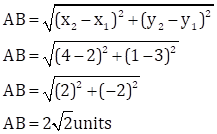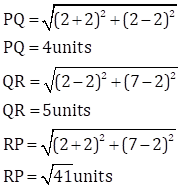Class 10 MAHARASHTRA STATE TEXTBOOK BUREAU Solutions Maths Chapter 5 - Coordinate Geometry
Coordinate Geometry Exercise 5.1
Solution 1(i)
Given:
A(2, 3)
B(4, 1)
We have to find the distance between A and B i.e., AB

Solution 1(ii)
Given:
P(-5, 7)
Q(-1, 3)
We have to find the distance between P and Q i.e., PQ

Solution 1(iii)
Given:
R(0, -3)
![]()
We have to find the distance between R and S i.e., RS

Solution 1(iv)
Given:
L(5, -8)
M(-7, -3)
We have to find the distance between L and M i.e., LM

Solution 1(v)
Given:
T(-3, 6)
R(9, -10)
We have to find the distance between T and R i.e., TR

Solution 1(vi)
Given:
![]()
X(11, 4)
We have to find the distance between W and X i.e., WX

Solution 2(i)
Given:
A(1, -3), B(2, -5), C(-4, 7)
To determine whether points A, B and C are collinear, we will have to find distances AB, BC and CA

As, we can see
BC=CA+AB
Thus, the points A, B and C are collinear.
Solution 2(ii)
Given:
L(-2, 3), M(1, -3), N(5, 4)
To determine whether points L, M and N are collinear, we will have to find distances LM, MN and NL

As, we can see
Thus, the points S, D and R are not collinear.
Solution 2(iv)
Given:
P(-2, 3), Q(1, 2), R(4, 1)
To determine whether points P, Q and R are collinear, we will have to find distances PQ, QR and RP

As, we can see
RP=QR+PQ
Thus, the points P, Q and R are collinear.
Solution 2(iii)
Given:
R(0, 3), D(2, 1), S(3, -1)
To determine whether points R, D and S are collinear, we will have to find distances RD, DS and SD

As, we can see
![]()
Thus, the points S, D and R are not collinear.
Solution 3
Given:
A(-3,4)
B(1,-4)
We have to find point on X-axis that is equidistant from A and B.
Let this point be C(0,a)
As, C is equidistant from A and B
AC=BC

The point on X-axis equidistant from A and B is ![]() .
.
Solution 4
Given:
P(-2, 2), Q(2, 2) and R(2, 7)
To verify that the given three points form a right-angled triangle,
We need to verify the Pythagoras theorem

According to the Pythagoras theorem,

Hence its verified that the points P, Q and R are vertices of right-angled triangle.
Solution 5
Given:
P(2, -2), Q(7, 3), R(11, -1) and S (6, -6)
We need to show that these four points are vertices of a parallelogram
In a parallelogram opposite sides are equal
Therefore,

We can observe that
PQ=RS
QR=SP
Hence P, Q, R and S are vertices of a parallelogram.
Solution 6
Given:
A(-4, -7), B(-1, 2), C(8, 5) and D(5, -4)
We have to show that these vertices are of a rhombus i.e., all the sides are equal.

As we can see,
AB=BC=CD=DA
Hence proved that points A, B, C and D are vertices of a rhombus.
Solution 7
Given:
L(x,7)
M(1,15)
LM=10
We have to find the value of x

The value of x is -5 or 7.
Solution 8
Given:
A(1, 2), B(1, 6), C(1 + 2 ![]() , 4)
, 4)
We have to show that these vertices are of an equilateral triangle
Therefore, we have to prove all the sides are equal in length

We can observe,
AB=BC=CA
Hence it is proved that A, B and C are vertices of an equilateral triangle.

